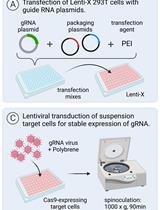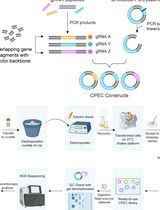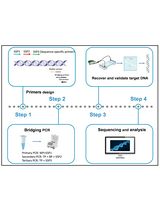- EN - English
- CN - 中文
Precision Tagging: A Novel Seamless Protein Tagging by Combinational Use of Type II and Type IIS Restriction Endonucleases
精确标记法:通过组合使用II型和IIS型限制性内切核酸酶的新颖无缝蛋白质标记法
(*contributed equally to this work) 发布: 2018年02月05日第8卷第3期 DOI: 10.21769/BioProtoc.2721 浏览次数: 9005
评审: Gal HaimovichOmar AkilKanika Gera
Abstract
Protein tagging is a powerful tool for performing comprehensive analyses of the biological functions of a protein of interest owing to the existence of a wide variety of tags. It becomes indispensable in some cases, such as in tracking protein dynamics in a live cell or adding a peptide epitope due to the lack of optimal antibodies. However, efficiently integrating an array of tags into the gene of interest remains a challenge. Traditional DNA recombinant technology based on type II restriction endonucleases renders protein tagging tedious and inefficient as well as the introduction of an unwanted junction sequence. In our attempt to tag Thrombospondin type 1 domain-containing 1 (THSD1) that we identified as the first intracranial aneurysm gene (Santiago-Sim et al., 2016), we developed a novel precision tagging technique by combinational use of type II and IIS restriction endonucleases (Xu et al., 2017), which generates a seamless clone with high efficiency. Here, we describe a protocol that not only provides a generalized strategy for any gene of interest but also takes its application of 11 different tags in THSD1 as a step-by-step example.
Keywords: DNA cloning (DNA克隆)Background
Versatile tags with different features serve as a set of tools to dissect protein function molecularly. Various tags such as Green Fluorescence Protein (GFP) tag and its derivatives, tandem affinity purification tags, such as FLAG-HA or ProtA-CBP, have revolutionized the biological research over the years. Some newly developed chemical tags, such as SNAP or CLIP, allow conditional labeling of the protein of interest in a time-controlled fashion (Bodor et al., 2012). However, a method to incorporate as many different tags as possible into a gene of interest efficiently has been poorly developed.
Traditional DNA recombination utilizes type II restriction endonucleases that recognize palindromic sequences. For example, EcoRI recognizes 5’-GAATTC and cleaves inside to make a 3’-AATT sticky end. When a protein needs different tags, it is a tedious and inefficient process that may also lead to the introduction of unwanted junction sequences due to the existence of a restriction recognition sequence. To improve the cloning efficiency, gateway technology takes advantage of another enzyme called integrase, which allows for site-specific recombination (Esposito et al., 2009). However, as patented technology, it requires that many essential reagents be purchased from designated resources. Also, the recognition sequence for integrase imposes a longer unwanted junction sequence between the tag and the protein of interest.
In our recent study to add 11 different tags to the N-terminus of THSD1, a single-span transmembrane protein responsible for cerebral aneurysm pathogenesis (Santiago-Sim et al., 2016), we developed a new cloning strategy by combinational use of type II and type IIS restriction endonucleases (Xu et al., 2017). Unlike type II, type IIS restriction endonucleases recognize non-palindromic sequences and cleave the DNA outside of their recognition site. For example, BsaI recognizes 5’-GGTCTC and cleaves the DNA a nucleotide downstream, resulting in a 5’ overhang 4 nucleotides long, thus making a custom sticky end that matches the gene of interest. Therefore, we can generate a seamless clone by completely eliminating the unwanted junction sequences (Xu et al., 2017). Even more importantly, using type II and type IIS restriction endonucleases in combination makes our method highly compatible with the traditional cloning system that is still widely used by many research labs. In addition, unlike gateway technology, precision tagging does not require designated destination vectors. Since each lab may favor a different set of destination vectors and tags for its gene of interest, our protocol affords researchers great flexibility in making their personalized tagging choices.
Materials and Reagents
- PCR tubes (Corning, Axygen®, catalog number: PCR-02-C )
- Pipette tips
- Razor blade (Fisher Scientific, catalog number: 12-640 )
- Microcentrifuge tubes, 1.5 ml (Fisher Scientific, catalog number: 05-408-129 )
- Petri dish, 100 mm (Fisher Scientific, catalog number: FB0875713 )
- DH5α competent cells (Thermo Fisher Scientific, InvitrogenTM, catalog number: 18265017 )
- Plasmids containing different tags:
pBabe-GFP (Addgene, catalog number: 10668 )
mCherry-Talin-H-18 (Addgene, catalog number: 62749 )
Dendra2-Vinculin-N-21 (Addgene, catalog number: 57749 )
pSNAPf-C1 (Addgene, catalog number: 58186 )
miniSOG-Zyxin-6 (Addgene, catalog number: 57781 ) - Type II restriction endonucleases such as:
EcoRI-HF (New England Biolabs, catalog number: R3101S )
BamHI-HF (New England Biolabs, catalog number: R3136S )
SalI-HF (New England Biolabs, catalog number: R3138S )
Bsu36I (New England Biolabs, catalog number: R0524S ) - Type IIS restriction endonucleases such as:
BsaI-HF (New England Biolabs, catalog number: R3535S )
BbsI-HF (New England Biolabs, catalog number: R3539S )
BsmBI (New England Biolabs, catalog number: R0580S ) - LB broth (Fisher Scientific, catalog number: BP1427-500 )
- LB agar (Fisher Scientific, catalog number: BP1425-500 )
- Ampicillin sodium salt (Fisher Scientific, catalog number: BP1760-5 )
- Calf intestinal alkaline phosphatase (CIP) (New England Biolabs, catalog number: M0290S )
- T4 polynucleotide kinase (New England Biolabs, catalog number: M0201S )
- pBS-KSII-4B was modified from pBS-KSII (accession number: X52327) by synonymously destroying BsaI site (Xu et al., 2017)
Note: It is available upon request and will be deposited to Addgene soon. - pCMV5 (accession number: AF239249, from lab stock and available upon request) and pBabe-puro (Addgene, catalog number: 1764 )
- Ultrapure water (Thermo Fisher Scientific, InvitrogenTM, catalog number: 10977015 )
- Phusion high-fidelity DNA polymerase (New England Biolabs, catalog number: M0530S )
- Custom DNA Oligonucleotides (Integrated DNA Technology)
- 1x Low-EDTA TE buffer pH 8.0 (Quality Biological, catalog number: 351-324-721 )
- 6x Gel loading dye, purple (New England Biolabs, catalog number: B7024S )
- Agarose (Thermo Fisher Scientific, Thermo ScientificTM, catalog number: 17850 )
- GeneRuler 1 kb DNA ladder (Thermo Fisher Scientific, Thermo ScientificTM, catalog number: SM0313 )
- 50x TAE (Bio-Rad Laboratories, catalog number: 1610773 )
- UltraPure Ethidium Bromide (Thermo Fisher Scientific, InvitrogenTM, catalog number: 15585011 )
- QIAquick gel extraction (QIAGEN, catalog number: 28704 )
- QIAquick PCR purification kit (QIAGEN, catalog number: 28104 )
- QIAprep spin miniprep kit (QIAGEN, catalog number: 27106 )
- Overlapping PCR (Recipe 1)
- In vitro digestion by restriction endonucleases (Recipe 2)
- Linearization of a vector by restriction endonucleases and dephosphorylation by calf intestinal alkaline phosphatase (CIP) (Recipe 3)
- In vitro DNA ligation (Recipe 4)
- DNA transformation (Recipe 5)
- In vitro DNA oligonucleotide annealing (Recipe 6)
- In vitro T4 polynucleotide kinase phosphorylation (Recipe 7)
Equipment
- Pipettes
- Thermo Cycler (Applied Biosystems) (or any other convention PCR device)
- DNA electrophoresis system (Takara Bio, model: Mupid-exU )
- 3UV lamp (Fisher Scientific)
- Water bath (VWR International), set at 37 °C for enzymatic digestion and 42 °C for DNA transformation into DH5α competent cells
- Heat block (VWR International), set at 55 °C for agarose gel dissolution
- Air incubator (VWR International), set at 37 °C for bacteria growth on LB plates
- Microcentrifuge (Eppendorf, model: 5424 )
- Orbital shaker (Forma Scientific), set at 37 °C for bacteria growth in LB medium
- ChemiDoc MP imaging system (Bio-Rad Laboratories, model: ChemiDocTM MP )
Software
- DNA sequence analysis software: Word, Vector NTI, DNAstar, or other
Procedure
文章信息
版权信息
© 2018 The Authors; exclusive licensee Bio-protocol LLC.
如何引用
Xu, Z., Rui, Y., Hagan, J. P. and Kim, D. H. (2018). Precision Tagging: A Novel Seamless Protein Tagging by Combinational Use of Type II and Type IIS Restriction Endonucleases. Bio-protocol 8(3): e2721. DOI: 10.21769/BioProtoc.2721.
分类
分子生物学 > DNA > DNA 克隆
您对这篇实验方法有问题吗?
在此处发布您的问题,我们将邀请本文作者来回答。同时,我们会将您的问题发布到Bio-protocol Exchange,以便寻求社区成员的帮助。
Share
Bluesky
X
Copy link














